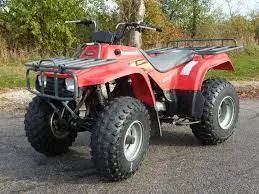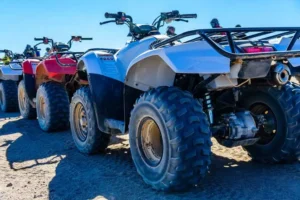Reviews
The Kawasaki Bayou 220 reviews, known for its simplicity and reliability, received generally positive reviews during its production years. Users appreciated its ease of use, durability, and suitability for both beginners and experienced riders. The ATV’s versatility in handling light work tasks on the farm or providing an enjoyable off-road experience was often highlighted.
However, as with any vehicle, some users reported issues over time, including concerns about the drum brakes and the need for periodic maintenance. It’s essential to note that individual experiences may vary, and the reviews are reflective of the model’s characteristics during its active production.[Kawasaki Bayou 220 Review Speed]
Speed
The top speed of the Kawasaki Bayou 220 is typically in the range of 40 to 45 miles per hour (64 to 72 kilometers per hour). Keep in mind that actual top speeds can be influenced by various factors, including rider weight, terrain conditions, and the state of the ATV (All-Terrain Vehicle).
For the most accurate and up-to-date information on the top speed of a specific Kawasaki Bayou 220 model, it’s recommended to consult the owner’s manual or contact a Kawasaki dealership. They can provide precise details based on the specifications of the particular ATV you are referring to.
Read About:
Kawasaki Bayou 300 Problems And Top Speed
5 Common Kawasaki Brute Force 300 Problems And Solutions [2024]
How to increase the speed of Kawasaki Bayou 220
Increasing the speed of an ATV, such as the Kawasaki Bayou 220, involves making modifications to the vehicle’s engine, transmission, and sometimes other components. However, it’s crucial to note that modifying an ATV may void warranties and can impact the vehicle’s safety and overall performance. Additionally, any modifications should comply with local laws and regulations. Here are some general tips for potentially increasing the speed of an ATV: [Kawasaki Bayou 220 Review Speed and Specifications]
-
Engine Performance:
Consider upgrading the air filter and exhaust system to enhance airflow and increase engine efficiency. Some riders opt for engine modifications, such as rejetting the carburetor or installing a high-performance camshaft. However, these modifications should be approached with caution and ideally done by experienced professionals.
-
Transmission Modifications:
Changing the gear ratios in the transmission can impact the ATV’s speed. This may involve replacing the stock sprockets with ones that have more teeth, providing a higher gear ratio for increased top speed.
-
Tire Selection:
Upgrading to larger or more performance-oriented tires can potentially increase top speed. However, this change may affect the ATV’s handling and acceleration, so careful consideration is necessary.
-
Weight Reduction:
Minimizing unnecessary weight on the ATV can improve its power-to-weight ratio. Consider removing accessories or components that are not essential for your riding needs.
-
Performance Tuning:
Some riders explore electronic performance tuners or engine control module (ECM) modifications to optimize engine performance. Again, this should be approached with caution and ideally performed by professionals familiar with the specific ATV model.
-
Professional Assistance:
Consulting with experienced ATV mechanics or professionals who specialize in performance modifications is advisable. They can provide insights into the potential modifications that are safe and effective for your specific ATV model.
It’s important to note that modifying an ATV carries risks, including potential damage to the vehicle, increased wear and tear, and safety concerns. Before making any modifications, thoroughly research the specific model, consult with professionals, and be aware of the potential implications. Always adhere to local laws and regulations regarding vehicle modifications, and keep in mind that prioritizing safety is paramount.
Weight of Kawasaki Bayou 220
The curb weight of the Kawasaki Bayou 220 is approximately 441 pounds (200 kilograms). Keep in mind that this weight includes all fluids, such as fuel and oil, but does not include any additional cargo, accessories, or the weight of the rider.

Kawasaki Bayou 220 Specifications
Certainly! Here’s a table summarizing key specifications for the Kawasaki Bayou 220:
| Category | Specification |
|---|---|
| Engine Type | 4-stroke, air-cooled |
| Displacement | 215 cc |
| Bore x Stroke | 67.0 mm x 63.0 mm |
| Compression Ratio | 9.2:1 |
| Fuel System | Carburetor, Mikuni B24 |
| Ignition System | Magneto CDI |
| Starting System | Electric start with recoil backup |
| Transmission | 5-speed, constant mesh, manual |
| Final Drive | Shaft |
| Front Suspension | McPherson strut, 3.1 inches travel |
| Rear Suspension | Swingarm, 3.1 inches travel |
| Front Brake Type | Drum |
| Rear Brake Type | Drum |
| Front Tire Size | AT21x8-9 |
| Rear Tire Size | AT22x10-10 |
| Overall Length | 72.0 inches |
| Overall Width | 40.2 inches |
| Overall Height | 42.3 inches |
| Wheelbase | 43.9 inches |
| Ground Clearance | 6.1 inches |
| Fuel Capacity | 2.4 gallons |
| Curb Weight | 439.8 lbs |
Specifications:
- Engine:
- The Bayou 220 is typically powered by an air-cooled, four-stroke, single-cylinder engine.
- Engine displacement: Approximately 215 cc.
- Transmission:
- Equipped with a five-speed transmission and a reverse gear for versatility in various terrains.
- Suspension:
- Features a front suspension system with MacPherson struts and a rear suspension system with swingarm and single shock.
- Brakes:
- Front and rear drum brakes for effective stopping power.
- Tires:
- Off-road tires suitable for various terrains.
- Fuel Capacity:
- Holds around 2.4 gallons (9 liters) of fuel.
- Dimensions:
- Length: Approximately 75 inches (190.5 cm)
- Width: Approximately 40.6 inches (103.1 cm)
- Height: Approximately 41.3 inches (104.9 cm)
- Wheelbase: Approximately 43.9 inches (111.5 cm)
- Ground Clearance: Approximately 6.1 inches (15.5 cm)
- Weight:
- Curb Weight: Around 441 lbs (200 kg)
- Features:
- Rack on the front and rear for carrying cargo.
- Electric and kick start options for convenience.
- Tow hitch for light towing.

Conclusions:
The Kawasaki Bayou 220, renowned for reliability and versatility, strikes a balance between simplicity and functionality with its durable design and dependable four-stroke engine. Its moderate top speed, user-friendly features, and practical cargo racks cater to both recreational and utility use. Despite being out of production, the enduring popularity of the Bayou 220 attests to its legacy of reliability and ease of maintenance. While cautioning about modifications and emphasizing safety compliance, the ATV remains a respected choice for off-road enthusiasts valuing durability and adaptability.
In the realm of all-terrain vehicles, the Kawasaki Bayou 220 stands out for its enduring reliability and versatility. With a robust design and dependable four-stroke engine, it is an ideal companion for recreational rides and utilitarian tasks. The sustained popularity of the Bayou 220, despite its discontinuation, underscores its legacy of reliability and ease of maintenance. Emphasizing caution in modifications and adherence to safety regulations, the ATV remains a respected choice for those prioritizing durability and adaptability in off-road pursuits.
FAQs:
- What is the top speed of the Kawasaki Bayou 220?
- The top speed of the Kawasaki Bayou 220 is typically in the range of 40 to 45 miles per hour (64 to 72 kilometers per hour), but actual speeds can vary based on factors such as rider weight, terrain, and ATV condition.
- What type of maintenance does the Kawasaki Bayou 220 require?
- Regular maintenance for the Bayou 220 includes tasks such as oil changes, air filter checks, brake inspections, and general lubrication. Refer to the owner’s manual for a comprehensive maintenance schedule.
- Can I modify my Kawasaki Bayou 220 to increase its speed?
- While modifications are possible, it’s important to approach them with caution. Modifying the ATV may impact safety, reliability, and compliance with local regulations. Seek professional advice before making any modifications.
- What is the recommended tire pressure for the Kawasaki Bayou 220?
- The recommended tire pressure can vary based on factors like rider weight and intended use. Refer to the owner’s manual or check the information on the ATV’s tire sidewalls for the manufacturer’s recommended tire pressure.
- Is the Kawasaki Bayou 220 suitable for beginners?
- Yes, the Kawasaki Bayou 220 is often considered suitable for beginners due to its user-friendly design, moderate power delivery, and ease of handling. However, riders should always prioritize safety and wear appropriate protective gear.

